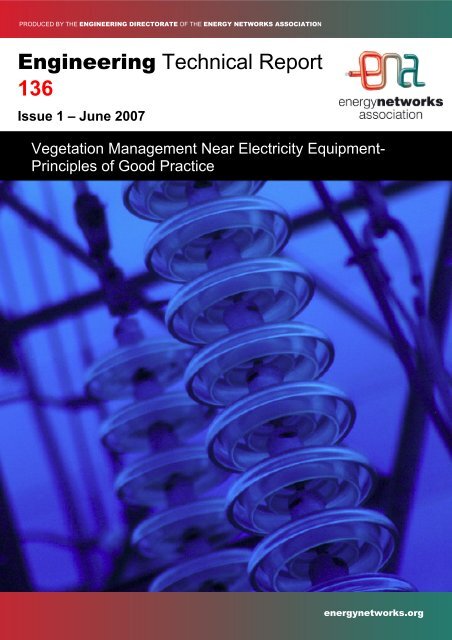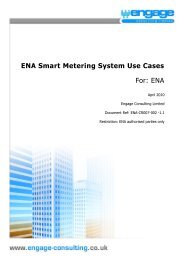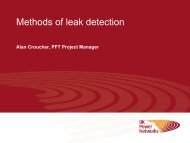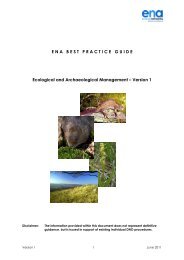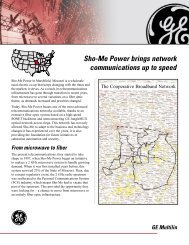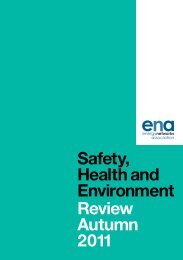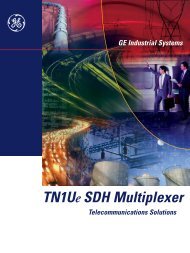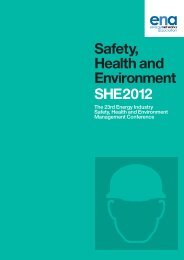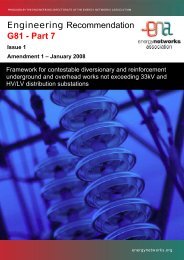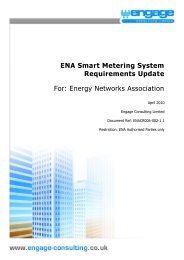ENA ETR 136 Issue 1 - Energy Networks Association
ENA ETR 136 Issue 1 - Energy Networks Association
ENA ETR 136 Issue 1 - Energy Networks Association
You also want an ePaper? Increase the reach of your titles
YUMPU automatically turns print PDFs into web optimized ePapers that Google loves.
PRODUCED BY THE ENGINEERING DIRECTORATE OF THE ENERGY NETWORKS ASSOCIATIONEngineering Technical Report<strong>136</strong><strong>Issue</strong> 1 – June 2007Vegetation Management Near Electricity Equipment-Principles of Good Practiceenergynetworks.org
© 2007 <strong>Energy</strong> <strong>Networks</strong> <strong>Association</strong>All rights reserved. No part of this publication may bereproduced, stored in a retrieval system or transmitted in anyform or by any means, electronic, mechanical, photocopying,recording or otherwise, without the prior written consent of<strong>Energy</strong> <strong>Networks</strong> <strong>Association</strong>. Specific enquiries concerning thisdocument should be addressed to:Engineering Directorate<strong>Energy</strong> <strong>Networks</strong> <strong>Association</strong>18 Stanhope PlaceMarble ArchLondonW2 2HHThis document has been prepared for use by members of the<strong>Energy</strong> <strong>Networks</strong> <strong>Association</strong> to take account of the conditionswhich apply to them. Advice should be taken from anappropriately qualified engineer on the suitability of thisdocument for any other purpose.
Engineering Technical Report <strong>136</strong><strong>Issue</strong> 1 – June 2007Page 1CONTENTSVEGETATION MANAGEMENT NEAR ELECTRICITY EQUIPMENT – PRINCIPLES OFGOOD PRACTICE................................................................................................................ 31. BACKGROUND ........................................................................................................... 32. PURPOSE ................................................................................................................... 33. SCOPE ........................................................................................................................ 34. DEFINITIONS .............................................................................................................. 45. LEGISLATION & GUIDANCE NOTES ......................................................................... 55.1. General .......................................................................................................... 55.2. Electricity Legislation...................................................................................... 55.3. Planning legislation (Town and Country Planning Act 1990 & relatedregulations and standards)............................................................................. 65.4. Forestry Act 1967, felling licences, Plant Health Act 1967 & subsequentorders............................................................................................................. 75.5. Wildlife & environmental legislation & good practice....................................... 85.6. Protection of birds (Schedule 1) ..................................................................... 85.7. Protection of other animals (Schedule 5)........................................................ 85.8. Protection of plants (Schedule 8).................................................................... 95.9. The Conservation (Natural Habitats, &c.) Regulations 1994........................... 95.10. The Countryside and Rights of Way Act 2000 (England and Wales) .............. 95.11. Good Practice - Veteran Trees....................................................................... 95.12. Site Safety and Occupier’s liability.................................................................. 95.13. Waste Management ..................................................................................... 106. CLEARANCES .......................................................................................................... 107. WAYLEAVES AND EASEMENTS / SERVITUDE ...................................................... 108. VEGETATION SURVEYING...................................................................................... 118.1. Information collected / included in the survey ............................................... 119. LAND OWNER APPROVALS AND COMMUNICATION ............................................ 119.1. Planning and liaison ..................................................................................... 119.2. Land Owner Approvals................................................................................. 1210. ACCESS TO LAND / PROPERTY ............................................................................. 1210.1. Conduct Whilst on Site ................................................................................. 1310.2. Single Farm Payment Scheme..................................................................... 1311. STANDARD OF WORK ............................................................................................. 1311.1. Integrated vegetation management .............................................................. 1311.2. Pruning......................................................................................................... 1411.3. Woodland management ............................................................................... 1411.4. Design of line clearance corridors (See also [14.1] Wildlife corridors) .......... 1511.5. Managing the risk of Wind blow.................................................................... 1511.6. Crown raising mature trees along lines......................................................... 1511.7. Line Clearance Corridor Harvesting & Thinning Operations ......................... 1511.8. Hedgerow management ............................................................................... 1611.9. 11.9. Herbicide treatment and growth regulators ......................................... 1711.10. Vegetation obstructing & infesting the bases of pylons, poles and groundmounted equipment...................................................................................... 1712. DISPOSAL OF ARISINGS ......................................................................................... 1712.1. Cut and stack on site.................................................................................... 1712.2. Cut and removal from site ............................................................................ 1712.3. Chip and spread on site ............................................................................... 1712.4. Chip and remove from site ........................................................................... 1712.5. Burning......................................................................................................... 1812.6. Recycling of Arisings.................................................................................... 1813. PLANTING / REPLANTING ....................................................................................... 18
Engineering Technical Report <strong>136</strong><strong>Issue</strong> 1 – June 2007Page 213.1. Planting of New Woodland ........................................................................... 1813.2. Replanting.................................................................................................... 1814. WILDLIFE .................................................................................................................. 1914.1. Wildlife Corridors.......................................................................................... 1915. TRAINING AND QUALIFICATIONS........................................................................... 2016. CONTRACTORS (INCLUDING CONTRACTOR PROFILE) ...................................... 2016.1. Service Provider Selection ........................................................................... 2016.2. Service Provider Management ..................................................................... 2117. RESOURCES ............................................................................................................ 2118. DISPUTE RESOLUTION – USE OF STATUTORY POWERS ................................... 21REFERENCES ................................................................................................................... 23BIBLIOGRAPHY ................................................................................................................. 24GLOSSARY OF TERMS..................................................................................................... 25ANNEX A EXAMPLES OF PROTECTED SITES ............................................................ 26FIGURESTable 1 - Examples of suitable tree species .................................................................... 19
Engineering Technical Report <strong>136</strong><strong>Issue</strong> 1 – June 2007Page 3VEGETATION MANAGEMENT NEAR ELECTRICITY EQUIPMENT – PRINCIPLES OFGOOD PRACTICE1. BACKGROUNDThis <strong>ETR</strong> has been developed following the publication of <strong>ETR</strong> 132, ‘Improving NetworkPerformance Under Abnormal Weather Conditions by Use Of A Risk Based Approach ToVegetation Management Near Electric Overhead Lines’. External stakeholders wereconsulted and invited to comment on the draft of <strong>ETR</strong> 132, these included GovernmentDepartments, Environmental Groups, relevant Trade <strong>Association</strong>s and landowners. Fromthe comments received, and noting the comments received by the DTI on theirconsultation on the draft of the ESQC (Amendment) Regulations 2006, manystakeholders expressed a desire for the Network Operators to have a ‘Good PracticeGuide’ for site works undertaken on vegetation management.The scope of <strong>ETR</strong> 132 did not include a ‘Good Practice Guide’. However; the NetworkOperators recognise the benefit of such a document to all stakeholders in this activityincluding <strong>ENA</strong> member companies, landowners, customers etc. Hence this document hasbeen developed in order to meet the reasonable aspirations of stakeholders.2. PURPOSEThe aim of this <strong>ETR</strong> is to present generic principles of good practice for VegetationManagement in the vicinity of electricity networks and network equipment when in pursuitof compliance with the statutory obligations that are placed on Network Operators. Itexplains why Vegetation Management is necessary and how good co-operation canbenefit all stakeholders.3. SCOPEThis report provides non-prescriptive guidance for Network Operators and their Site Staffwhen engaged in Vegetation Management. The report covers all phases of work from theplanning stage through to completion and leaving site.There is guidance on how to manage the liaison between Network Operator andLandowner, including data exchange and management of any agreements between thetwo parties. This guidance is aimed to ensure good relationships between NetworkOperators and Landowners but it also provides advice on how to resolve disputes shouldthey occur.This report covers all areas of Vegetation Management in the vicinity of electricityequipment and not just tree cutting. The report recognises that Vegetation Management isa cyclic process which needs to be repeated after a period of years dependent upongrowth rates. Alternative Engineering solutions may be considered (Ref <strong>ETR</strong> 132 section6.2.3).There is guidance on the standard of Vegetation Management required and how to dealwith Arisings etc.This <strong>ETR</strong> is applicable to all public electricity <strong>Networks</strong> in the UK from 230V to 400,000V.
Engineering Technical Report <strong>136</strong><strong>Issue</strong> 1 – June 2007Page 4Guidance on safety related matters, such as safe working around Overhead Lines, isoutside the scope of this report. Guidance on such matters can be found in <strong>ENA</strong> ERG55/1 [Ref 1] and <strong>ENA</strong>-TS 43-8.4. DEFINITIONSFor the purposes of this Engineering Technical Report the following definitions apply.ArisingsAll vegetation waste resulting from line clearance activities.Network Operator (NO)The organization that owns and/or operates a distribution Network and is responsiblefor keeping Vegetation clear of Overhead Lines. A NO might also be referred to as aDistribution Network Operator (DNO) or Transmission system operator (TSO).VoltagesLow voltage (LV) – taken from ESQCR 2002[Ref 2]Means - in relation to alternating current, a voltage exceeding 50 volts measuredbetween phase conductors (or between phase conductors and earth), but notexceeding 1000 volts measured between phase conductors (or 600 volts if measuredbetween phase conductors and earth), calculated by taking the square root of themean of the squares of the instantaneous values of a voltage during a complete cycle.High voltage (HV) – taken from ESQCR 2002[Ref 2]Means any voltage exceeding 1000V.Extra High Voltage (EHV)Means any voltage exceeding 20,000V.LandownerMeans a person who either owns or is in actual occupation of the land.Line ConductorA conductor used, or to be used, for conveying a supply of electricity. A line conductoris deemed to include a through jumper.NetworkMeans all those elements of the NO’s electrical infrastructure associated with thetransmission and distribution of electrical energy. This includes, but is not limited to,Overhead Lines, Overhead Line supports, stay wires, pole mounted transformers andswitchgear.Overhead Line (OHL) – taken from ESQCR 2002[Ref 2]Means any electric line which is placed above ground and in the open air.Protected SitesThis is an all encompassing term used to describe those areas that because of theflora and/or fauna present or other feature, carries some form of statutory protectionthat may affect, or be affected by, Vegetation Management. Examples of ProtectedSites are shown under Annex A to this <strong>ETR</strong>.
Engineering Technical Report <strong>136</strong><strong>Issue</strong> 1 – June 2007Page 5Safety DistanceDistance from nearest exposed conductor or from an insulator supporting a conductorwhich is maintained to avoid danger.NOTE: This definition has been taken from <strong>ENA</strong>-TS 43-8 [Ref 1], therefore it shouldbe seen in the context of that document and not confused with safety clearances thatare described in other safety literature.SpanThe overhead lines between two adjacent supporting poles or structures.Utility ArboristAn individual who is knowledgeable about the needs of trees and is trained andequipped to provide proper care, also to carry out the specialist managementtechniques associated with vegetation in proximity to power lines and who holds theappropriate certification credentials and qualifications. In addition the individual willhave sufficient technical knowledge or experience in basic electrical safety to avoiddanger.VegetationAll plant life including, but not limited to, trees, shrubs, hedges and grasses butexcluding lawns.Vegetation ManagementAn all encompassing term which includes, but is not limited to: tree felling and pruning,herbicide application, hedge and ground maintenance and coppicing.Wayleave / Easement - ServitudeA legally enforceable agreement between a Landowner and a NO for placingelectricity <strong>Networks</strong> over the land.5. LEGISLATION & GUIDANCE NOTES5.1. GeneralVegetation management by NOs is driven by Electricity legislation, which requires andenables the maintenance of clearances from <strong>Networks</strong> to adjacent vegetation.However the nature of the work means that other legislation such as planning, forestryand wildlife law, health and safety law and common law all have a bearing.This section describes the main legislation and standards which apply.5.2. Electricity LegislationElectricity Act 1989Schedule 4, Paragraph 9 – ‘Felling and lopping of trees etc.’Generally, the owner of the land where the lines are situated is responsible formanaging trees and can reclaim costs from the NOs. However, cutting trees in closeproximity to live electricity overhead lines can be very dangerous if persons are nottrained in this work. Consequently it is common for most NOs to offer to undertake thenecessary work on the landowners behalf. In cases where landowner’s are unwillingto allow works to be undertaken the NO has powers under Schedule 4 para 9 to givenotice to the Landowner requesting work to be carried out. If necessary the NO willcarry out the work 21 days following the notice, subject to an objection procedure.Disputes are referred to the Secretary of State. The NO is required to:-
Engineering Technical Report <strong>136</strong><strong>Issue</strong> 1 – June 2007Page 6 Give notice to both the occupier and the landowner, if the two are different. Work in accordance with obligations under schedule 9 of the Electricity Act(Preservation of Amenity) observing good arboricultural practice and so as todo as little damage as possible to trees, fences, hedges and growing crops. Cause felled trees, lopped boughs or root cuttings to be removed inaccordance with the directions of the landowner or occupier. Make good any damage done to the land. For Safety reasons given above the NO will usually offer to undertake thework specified in the notice.(see- www.dti.gov.uk/files/file34072.pdf)Electricity Safety, Quality and Continuity Regulations (ESQCR 2002) asamended.NOs have a duty under the Electricity Safety, Quality and Continuity Regulations (asamended) to keep sufficient distance between vegetation and overhead lines both tosafeguard public safety and to ensure continuity of supply. This should help thenetwork to be more resilient to the effect of severe weather. It may result in moreextensive tree cutting to be carried out than before, with trees that pose a high riskbeing removed (Refer to DTI statement – Management of vegetation near overheadpower lines)Electricity at Work Regulations 1989These Regulations impose a duty of care on all employers (including landownersemploying their own labour or using third parties) to ensure safe working practices foremployees and others with regard to electricity at work. In practice this implieslandowners seeking the advice of the NOs and having regard to HSE advice whenplanning vegetation management near overhead conductors.5.3. Planning legislation (Town and Country Planning Act 1990 & relatedregulations and standards)Vegetation management by NOs often involves work to protected trees. These maybe the subject of a tree preservation order, or be protected because of their inclusionin a planning conservation area, or as a condition of a planning consent. Often theywill be the subject of intense public interest and concern.Tree Preservation OrdersThe law on TPOs in England and Wales is set out in the Town and Country PlanningAct 1990 and Statutory Instrument 1999 No. 1892, the Town and Country Planning(Trees) Regulations 1999. In Scotland, TPOs are governed by the Town and CountryPlanning (Scotland) Act 1997 A TPO prohibits the cutting down, uprooting, topping,lopping, wilful damage or wilful destruction of trees without the consent of the LocalPlanning Authority (including, in the Secretary of State’s view – the cutting of roots).Also see ‘Tree Preservation Orders: A guide to the law and good practice’, chapter 6.(Published by Department for Communities & Local Government.www.communities.gov.uk)NOs have clear exemptions with regard to TPO’s. Exemptions from the need to obtainthe Local Planning Authority’s consent or give them notice are in each TPO. TPOsusually include an exemption allowing NOs to carry out works on trees which interferewith the maintenance of electric lines or in the interests of the safe operation of thenetwork. Operators should always follow industry codes of practice:- National Joint Utility Group - Guidelines for the planning, installation andmaintenance of utility services in relation to trees.
Engineering Technical Report <strong>136</strong><strong>Issue</strong> 1 – June 2007Page 8Disease & Invertebrate ordersWork may involve vegetation subject to a disease order – for instance the Plant HealthPhytophthora ramorum order SI 2004 no 3213, or where a notifiable invertebrate suchas the Great Spruce Bark Beetle (Dendroctonus micans) is detected. It is a legal dutyto inform the Forestry Commission when a notifiable pest is detected, or when workingin an area covered by a restriction imposed by an order.5.5. Wildlife & Environmental legislation & good practiceThe major legal instrument for wildlife protection in the UK (excluding NorthernIreland, the Channel Islands and the Isle of Man) is the Wildlife and Countryside Act1981 (as amended), although other significant legislation has followed; notably theEnvironmental Protection Act 1990, the Protection of Badgers Act 1992, theCountryside and Rights of Way Act 2000 (England and Wales), the Conservation(Natural Habitats &c.) Regulations 1994 and Nature Conservation (Scotland) Act2004. The Wildlife and Countryside act itself has been significantly amended and theschedules of protected species are subject to five yearly statutory review.It is the means by which the Convention on the Conservation of European Wildlife (the‘Bern’ convention) and European Union Directives on the Conservation of Wild Birds(79/409/EEC), Natural Habitats, Wild Fauna and Flora are also implemented in allparts of the UK.NOs have a duty under the Natural Environment and Rural Communities Act 2006 tohave regard, so far as is consistent with the proper exercise of their functions, to thepurpose of conserving biodiversity.Also related to NO tree work, the Wildlife and Countryside Act 1981 requiressurveying authorities to maintain up to date definitive maps and statements, for thepurpose of clarifying public rights of way. (Reference - Joint Nature ConservationCommittee / UK legislation / Wildlife & Countryside Act 1981: www.jncc.gov.uk)Work affecting protected species may require a license.The main issues under the Wildlife and Countryside Act relating to NO vegetationmanagement are set out below:-5.6. Protection of birds (Schedule 1)Under the act, it is an offence to kill, injure or take any wild bird, or to take, damage ordestroy the nest or the eggs of a wild bird while in use or being built. (Authorisedpeople may take or disturb pest species in special circumstances).There areadditional penalties relating to disturbing listed (schedule 1) nesting birds at nest.Areas of special protection are designated where access is restricted and disturbanceprohibited (see Annex A).5.7. Protection of other animals (Schedule 5)Under the act, the intentional killing, injuring or taking of listed (schedule 5) wildanimals is prohibited. In addition places used for shelter and protection aresafeguarded against intentional damage, destruction and obstruction and protectedanimals must not intentionally be disturbed while occupying those places.Examples of currently listed mammals relevant to NO vegetation management includeall Bats, Dormouse, Red Squirrel, Wild Cat and Pine Marten, Smooth Snakes, Sand
Engineering Technical Report <strong>136</strong><strong>Issue</strong> 1 – June 2007Page 9Lizards, Great Crested Newts, Natterjack Toads and several invertebrates. All reptilesare protected from deliberate harm or destruction” .Badgers are protected by The Protection of Badgers Act 1992, under which it is acriminal offence:• to wilfully kill, injure, take, possess or cruelly ill-treat a badger, or attempt to doso;• to interfere with a sett by damaging or destroying it;• to obstruct access to, or any entrance of, a badger sett;• to disturb a badger when it is occupying a sett.5.8. Protection of plants (Schedule 8)The act prohibits the unauthorised intentional uprooting of any wild plant species andforbids any picking, uprooting or destruction of certain listed plants (schedule 8).The Wildlife and Countryside Act lists exemptions covering NOs.5.9. The Conservation (Natural Habitats, &c.) Regulations 1994These regulations implement a register of important wildlife sites in Britain, creatingpowers to make special nature conservation orders. They allow managementagreements to be created to control potentially damaging operations, creation ofbylaws, compulsory purchase of sites, a requirement to give notice of proposed worksand set out fines for offences.The regulations afford special protection to a range of wildlife species and the placesthat they inhabit, for example Otters, Red Squirrels, Dormice, and Great CrestedNewts5.10. The Countryside and Rights of Way Act 2000 (England and Wales)Among other changes this strengthens protection for Sites of Special ScientificInterest, provides greater recognition for Areas of Outstanding Natural Beauty, andrequires certain bodies to have regard for AONB’s when doing anything which wouldaffect the land. It also makes it an offence to recklessly disturb a place of rest orshelter of a protected animal or a nest site and increases penalties for offences.5.11. Good Practice - Veteran Trees“A veteran tree can be defined as a tree that is of interest biologically, aesthetically orculturally because of its age, size or condition.” Reference – Veteran Trees: A guide togood management (English Nature).Where veteran trees are in proximity to overhead electricity lines good practice is –where practicable - to actively seek management solutions that remove unacceptablerisk to the overhead line but retain the distinctive value of the tree. An example mightbe to consider crown reduction rather than automatic felling.5.12. Site Safety and Occupier’s liabilityThe Occupier’s Liability Act 1984 (amended) (England and Wales only) places a dutyof care on the landowner towards visitors and other persons. Good practice is wherework is completed to good safety standards, sites are always left in a safe condition,and that unfinished work is signed and guarded, in a manner which allows landownersto fulfil their duty of care in relation to work carried out by the NO on their behalf.
Engineering Technical Report <strong>136</strong><strong>Issue</strong> 1 – June 2007Page 105.13. Waste ManagementWaste Management is a complex area of legislation. Specific guidance should besought regarding any proposed waste management, carriage or disposal activity.In England and Wales the Environment Agency (EA) enforces regulations and issueslicences and exemptions for a range of waste management activities (tel helpline –08708 506506). In Scotland the Scottish Environment Protection Agency (SEPA) tel01786 457700 is the regulator, or the Environment and Heritage Service (EHSNI) inNorthern Ireland; tel 028 90569370.In general commercial businesses need to be licensed to manage waste or need toregister for an exemption for a specific waste management, carriage or recyclingactivity (for instance: carriage, storage and recycling of wood chips).6. CLEARANCESIndividual NOs need to adjust their particular clearance specifications to reflect their ownoperating conditions under ESQCR, in terms of safety and resilience and the nature of thevegetation heritage, public interest and risk in different areas.NOs must add to the safety clearances given in <strong>ENA</strong>-TS 43-8 reasonable allowances forexpected re-growth of vegetation over the period between scheduled maintenance visits(“the cutting cycle”). In addition to this clearance, NOs must also allow for swaying ofvegetation in storms, sag of electricity conductors in high temperatures, and theoperational risk of airborne debris, snow loading of branches, branch breakages and windblown trees hitting the overhead lines in major storms.Cutting to a specified set clearance from the overhead line looks aesthetically poor andoften damages plant health because the tree or shrub’s natural internal injury repairmechanisms have been impaired. Good arboriculture and forestry practice also requiresformative pruning and selection of trees for felling or retention outside the immediateengineering clearance to allow the development of strong, attractive and healthyvegetation which will greatly lessen the risk to overhead lines.Permanent ClearancesUnder certain circumstances the NO may consider terms for the sterilisation of permanentclearance areas in return for the grant of an easement/servitude.7. WAYLEAVES AND EASEMENTS / SERVITUDEThe majority of a NO’s assets are held on private land and in most cases this is by virtueof long-standing relationships which are valued by NOs. Legal rights exist between theparties in the form of formal or implied wayleaves, or formal easements which areregistered against the title of the property. In all cases: In relation to the exercise of existing rights, it is important for a NO (or itscontractor) to ensure that good communications and agreements are in placewith the Landowner in accordance with the Land owner approvals andCommunication section below. It should be considered reasonable by both parties for a NO to look to itsexisting legal rights in respect of the maintenance and operation of its networkin accordance with its statutory and operational obligations. A NO is obliged to discuss and negotiate with a landowner any activities whichare beyond the scope of its legal rights.
Engineering Technical Report <strong>136</strong><strong>Issue</strong> 1 – June 2007Page 11Where a NO’s legal rights provide a restriction on the type of planting which aLandowner can undertake in the vicinity of a line, it is reasonable for the NO toseek to enforce the restriction as a means of managing the growth ofvegetation in accordance with its statutory obligations.In respect of the purchase of new rights over land it is good practice for aNO’s negotiations to seek standard terms for Easement / Servitude andWayleave which are capable of restricting inappropriate planting byLandowners beneath the line. This will eliminate any uncertainty for bothparties in the future.Where existing legal wayleaves / easements / servitude are unsuitable for theNO’s statutory obligations and where agreement with a landowner cannot bereached, regard should be given to the Escalation Procedure section of thisdocument at section 18.8. VEGETATION SURVEYINGThe survey is critical to the success of the operation and requires the surveyor to beequipped with a range of skills including: Safety Knowledge Arboricultural knowledge / Vegetation management expertise Environmental awareness Electrical knowledge Customer care Negotiation skillsThe Surveyor should be able to demonstrate adequate knowledge in these varied skillsthrough appropriate training or qualifications.8.1. Information collected / included in the surveyIt is vital that the survey collects all relevant data that will support the request to thelandowner to carry out work and to enable the surveys and completed work to beauditable. The information collected may include, but not restricted to, the following: Location (Pole No. From/ To) Risk rating Shutdown Requirements / Interruption to supply Species of Tree Involved Tree Defects Work Required Clearance to conductors.9. LAND OWNER APPROVALS AND COMMUNICATION9.1. Planning and liaisonGood planning and clear communication of plans are essential for a successful cyclicmanagement programme to achieve compliance with statutory requirements and meetthe expectations of customers and landowners. The communication process must beactively managed by the NO.NO’s may consider discussing the following: Programme planning across a number of years. It is the fundamental basis of good customer information to share withlandowners and major stakeholders the NO’s long term plans for the site. Sharing the programme plan with major stakeholders at the forming stage.
Engineering Technical Report <strong>136</strong><strong>Issue</strong> 1 – June 2007Page 12The inclusion of major stakeholders and landowners at the programme formingstage will improve resolution of issues that are bound to develop.Communication items recommended to be included are: The statutory obligation on the NO’s to deliver safety clearances and continuityof supply to assets in accordance with ESQCR. Commitment to customer consultation and information from plan conceptthrough to delivery. Commitment with respect to the environment. Explain the need for regular repeat cutting unless “clear fell” solutions arepermitted. Permanent / clear fell solutions.9.2. Land Owner ApprovalsEffective communication is an important issue for a NO to consider in relation to anyvegetation management which it wishes to undertake on private land. This is relevantwith regard to both the short-term success of its project and also its important longtermrelationship with the landowner.Detailed discussions with the landowner are necessary to ensure an understandingand agreement exists under a number of headings - both in terms of basic detail suchas the proposed timing of the works and also more specific technical issues such asthe nature of the work to be undertaken.The following are all examples of good practice: During pre-work discussions, it is important for the NO to explain to thelandowner the statutory / operational reasons for its proposed works. No work should be carried out without written consent. However, If a writtenconsent is not forthcoming the details of the verbal agreement should berecorded on the consent form and the circumstances noted. The consent should include details of the specific work to be undertaken ateach location in addition to detailing the agreed vehicular and pedestrianaccess arrangements to and from the site and agree disposal of arisings. The consent form should describe the work at each site using well definedarboricultural terms. Use of illustrative diagrams and photos could also beconsidered. A copy of relevant paperwork should be left with the Landowner. A definition of the terms used on the Consent form could be provided to giveclarity. Care should be taken to consider the impact of the NO’s proposals in relationto any cultivations / husbandry or bio security which the landowner may wish tocarry out and how the NO sought to minimise the environmental impact. Landowners should inform NOs if they are members of any AssuranceSchemes (i.e Organic, Forest Certification etc) that may affect methods ofworking The NO should provide the landowner with (named) contact details.10. ACCESS TO LAND / PROPERTYLand access may be required at any time during the course of the year but should betaken with due regard to the nature and usage of the land. Prior to access being takenand cutting taking place, appropriate agreements with the affected Landowners should bein place as described above.The following should be observed by the NO:
Engineering Technical Report <strong>136</strong><strong>Issue</strong> 1 – June 2007Page 13Site staff should be aware of the landowner details and should have copies ofthe relevant consent forms.Access should be taken in accordance with consent forms and Wayleaveagreements (where appropriate).Site staff should endeavour to communicate with the Landowner beforeaccessing work areas.A number of areas require additional precautions (for example) Protected sites (including SSSI’s). Permission to access such sites must beobtained from the managing authority e.g. English Nature, Local Authorities. Consultations should be made with other appropriate bodies in conjunctionwith the landowner / tenant. Network Rail Sites can only accessed with the consent of and under thesupervision of Network Rail. Access to Forestry Commission land must be in accordance with the NationalAgreement.10.1. Conduct Whilst on SiteA professional and courteous attitude by all site staff is important to maintaining goodrelations and to ensure that accidents do not arise in relation to stock managementand site safety. The following are examples of good practice: A rigorous approach to site safety management should be maintained. The NOs conduct and works should comply with its published policy. Staff to conduct themselves in a professional manner at all times. Take access only along agreed routes. Ensure that gates are left as found. Unless specifically agreed with thelandowner. Ensure that appropriate provision is made to exclude stock from the workingarea. Comply with statutory disease control measures. Leave the site in a tidy and workmanlike state at the end of each day. Make good on a timely basis in respect of any surface damage. All staff should carry personal identification. Consideration of neighbours & the public. No dogs to be allowed on site10.2. Single Farm Payment SchemeThis type of work would normally be treated as being beyond the Farmer’s control, sothe farmer would not be held responsible for damage and it would not be perceived asa non-compliance. However farmers should make every effort to discuss with the NOthe work to be done and minimise damage as a result of the work (Source: Defradocument PB10763, FAQ111)11 STANDARD OF WORK11.1. Integrated vegetation managementGood vegetation management is based on an understanding of the inter-relationshipsbetween plants and their environment. This ‘holistic’ understanding can be effectivelyused to manage species composition, tree stability, and competition between plants,levels of light and predation levels on plants. Chainsaw cutting is only one availabletool; use of herbicides and naturally occurring growth hormones (subject to labelapprovals), natural interactions between plants, machine mulching treatments andplanting low growing species may also be considered.
11.2. PruningEngineering Technical Report <strong>136</strong><strong>Issue</strong> 1 – June 2007Page 14The aim of pruning should be to achieve vegetation clearances in ways whichminimise the aesthetic and physical impact on retained trees and shrubs.Reasonable care should be taken to avoid unnecessary damage to flora and faunaand to access ways.Work should comply with BS3998 (Recommendations for tree work as amended).Pruning is a skilled job which should be undertaken by appropriately trained andexperienced staff.Given constraints often imposed by others it is not always possible to prune in anaesthetically pleasing way. However an effective Utility Arborist adjusts the workcarried out for each plant to achieve the best possible standard, given the prevailingconstraints. Ideally vegetation is left well balanced with natural crown shapes. Pruning must also take into account the vegetation re-growth expected in theinterval between cuts. This will vary widely between plant species and sites. Vegetation management: tree selection for retention and replanting at an earlystage can be used to prevent the need for much more intrusive and damagingwork in the future when the vegetation grows closer to the overhead line. Goodpractice often involves interventions over a number of cutting cycles to managetrees and shrubs so that future conflict with overhead electricity lines is minimised. Where reasonably possible avoid recognised injurious practices such as:-o Topping or lopping to an arbitrary height or branch lengtho Unbalancing a tree crown by excessive one-sided pruningo Pollarding. Unless pollarding is the existing recognised managementtechnique.o Inappropriate use of flailing.o Climbing damage - Care should be taken to avoid injuring thin and weakbarked species by inappropriate use of rope access techniques.o Access damage - Vehicle access and treatment of arisings should avoidinjury to low branches, stems, root buttresses and feeder roots.o Spreading Disease - Appropriate regard should be given to avoidspreading fungal diseases. If the only pruning option is to severely reduce or unbalance a tree, thencoppicing, or felling and replacement planting are often better options.11.3. Woodland managementManagement of line clearance corridors in woodlands should aim to create adequateclearance around overhead lines while encouraging healthy growth and stability ofsurrounding retained trees. It is often possible to manage a line clearance corridor in away that also benefits the woodland manager’s wider objectives and responsibilities.In order to be sustainable woodlands need a diverse mix of habitat edges, plantdiversity, wildlife glades and areas of open sunlit space, as well as good points ofaccess. The growing reality of climatic change also reinforces the importance of goodfire breaks. Managed correctly, electricity clearance corridors provide these. The NO’saim of creating a wind firm crop around a corridor can complement the woodlandmanager’s need to manage a thinning programme in that part of the wood.A key consideration for any woodland manager must also be to safeguard the healthand safety of the woodland thinning and harvesting workforce, by avoiding a situationwhere tree growth camouflages the position of overhead electricity conductors. The
Engineering Technical Report <strong>136</strong><strong>Issue</strong> 1 – June 2007Page 15NO can provide advice on issues such as felling and machine access aroundoverhead lines, safety signing and goal posting access routes in order to comply withHSE publications AFAG 404, 804 & GS6.11.4. Design of line clearance corridors (See also [14.1] Wildlife corridors)Forestry Commission guidelines (See references) state that “the aim should be acorridor of varying width and character”. Woodland edges can be often be scalloped.Low growing native trees or shrubs such as Hazel, Hawthorn, Elder, Blackthorn,Guelder Rose, Rowan, Wayfaring Tree, Privet and Gorse can be maintained in anirregular coppice matrix in order to break up the corridor into more natural lookingglades. Hedgerows can be maintained at woodland edges.11.5. Managing the risk of Wind blowDifferent techniques will be appropriate in different situations; for instance: Early felling of unstable crops around overhead electricity lines. Side prune rather than fell an exposed wind-firm conifer edge to avoidexposing unstable crop trees. Carefully thin an existing crop to favour and develop new edge trees inadvance of widening a corridor in order to improve the stability of theremaining crop.Forestry Commission advice is that intervention when crops are young and small willgreatly reduce the risk. Where feasible felling should always be to a windfirm edge.11.6. Crown raising mature trees along linesCrown raising of mature trees alongside an overhead line (by removing lowerbranches which may encroach on the line) may sometimes be considered by a NO tobe an appropriate management technique on circuits when retention of the trees isconsidered essential. This is only considered appropriate where trees are considered“windfirm”. Retaining mature trees may help reduce available light to vegetationgrowing underneath a line. However network safety, security and storm clearanceconstraints will often necessitate the removal of mature trees close to the line.It is unacceptable for weak vegetation to be leaning towards or overhanging electricitycircuits, which may be important distribution circuits serving hundreds or thousands ofcustomers. [Reference <strong>ETR</strong>132].11.7. Line Clearance Corridor Harvesting & Thinning OperationsWork carried out by tree teams on behalf of NOs should comply with good forestrypractice:- Presentation of produce should be in neat, safely stacked and signed pilesready for forwarder / tractor pick-up. Cut and present material as agreed with the woodland manager. Sites should be left tidy, with brash and stumps cut low and neatly with anyhinge or jagged spikes removed, to prevent them becoming a trip hazard or anobstacle to vehicles. Remove litter. Stack brash neatly and maintain good access for line inspection along thelength of the span. Leave water courses, culverts and ditches undamaged and clear of arisings. Avoid damaging those standing trees which are to be retained. No fires should be lit without permission, or close to retained trees. Tracks should not be allowed to become heavily (excessively?) rutted. Trackswhich become rutted as a result of NO activities should be made good.
Engineering Technical Report <strong>136</strong><strong>Issue</strong> 1 – June 2007Page 16Safety - Cooperate with the Forest manager’s own risk managementframework as set out in the HSE publication ‘Managing Health and Safety inForestry”. Forest operations are particularly hazardous so only use staffqualified in the particular task. Machinery operations must meet the standardsset out in the HSE publication “Management of Electricity at Work: Forestryand Arboriculture”. Warning signs should be posted at the main access pointsduring work.Where required by the Landowner. Conifer stumps may be treated for thedecay fungus Heterobasidion annosum (formerly known as Fomes). Brashshould be clear of stumps and dye should be added to render the treatmentclearly visible after application. Phlebiopsis gigantea based biologicaltreatments, such as Rotstop and PG Solution, are currently licensed only foruse on Pine plantations.11.8. Hedgerow managementGood hedgerow management under electricity lines should preserve the function,aesthetics and cultural value of hedgerows, by reflecting their character andcomplementing (and informing) the management objectives of the Landowner oroccupier. At its best, hedgerow management under electricity lines using traditionalregional styles can be a benchmark for others to copy. Poor hedgerow managementremains a major cause of vegetation management related landowner complaints.Many hedges will be subject to specific management schemes (eg CountrysideStewardship Scheme). NOs should have due regard to any requirements which thelandowner may request in this respectThe most common method of management is hedge trimming by machine flailedmethods.Other methods which may be considered in exceptional circumstances include:Hedge Laying (syn. ‘Layering’, ‘steeping’, ‘plashing’) is the traditional practiceof regenerating stock hedges at their base, for the purpose of retaining orimproving stock-proofing. Laying is only appropriate for the right context,material availability, condition of bank or ground and available light levels andwill only be achieved by staff who are appropriately trained and experienced.Coppicing is a very useful technique for regenerating hedges from the base. Ina very wide hedge, or where a hedge runs both sides of a lane or track, it maybe possible to set up a coppice rotation which allows permanent screening orstock-proofing to be retained. Problems arise when coppice cuts arepositioned too high above ground level, since re-growth occurs largely justbelow the cutting point, leaving gaps at ground level. Good practice is to cutcoppice as low as stock proofing requirements and rabbit browsing pressureswill permit.Hedgerow regeneration depends on the re-growth being protected frombrowsing by stock or wild animals. Hedgerow management which inadvertentlyresults in gaps may necessitate fencing to prevent stock escaping. Any workcarried out should not hinder the landowner from carrying out essential bankin-filling, fencing and drain restoration works. NOs’ teams must exercise greatcare in ensuring the security of farm stock (see 9 Landowner Approvals andCommunications).
11.9. Herbicide treatment and growth regulatorsEngineering Technical Report <strong>136</strong><strong>Issue</strong> 1 – June 2007Page 17Herbicide control of stumps and re-growth can be a useful management tool forselective species control, allowing fast or tall growing species to be replaced withlower and slower growing species (See table 1 for examples). Growth regulatorsbased on naturally occurring plant hormones may in future provide a much lessdamaging alternative to cutting for the maintenance of selected amenity trees.Application of herbicides and growth regulators must be in accordance with thelandowners preferences and appropriate Code of Practice published by HSE.11.10. Vegetation obstructing & infesting the bases of pylons, poles and groundmounted equipmentIt is important for NOs to maintain good access to towers, poles, stay wires andaround ground based or pole mounted equipment. Ivy, Clematis, other climbers, orsaplings and branches interfering with poles and towers, equipment and fencing mustbe removed as they can become serious safety hazards and provide unauthorisedclimbing aids. Good vegetation management around such equipment will achieve aneat appearance. Arisings should not be left scattered.It may not be appropriate to completely clear around poles located in stock proofhedgerows, other than maintaining the normal hedge height. However good accessshould be maintained to pole mounted switches, control boxes, or other equipmentwhich is normally operated from ground level. Where a hedge is normally tractorflailed by a landowner, any growth which has been left uncut around the equipmentshould be reduced to hedge maintenance height.12. DISPOSAL OF ARISINGSEffective communication should take place between site staff and the Landowner. Writtenconsent should be obtained prior to any tree management work taking place,documenting the Landowner’s requirements for the disposal of arisings.The disposal of Arisings should comply with good arboricultural and environmentalpractice. All relevant environmental legislation should be complied with at all times.Any toxic arisings such as Ragwort, Blackthorn, Yew & Rhododendron should be madesafe in respect of livestock.Common options include:12.1. Cut and stack on site.Cut Wood should be delimbed and stacked to a specification agreed with thelandowner. Cut arisings should be stacked in tidy heaps as agreed with the landownerto provide wildlife habitat sites which will naturally decompose.12.2. Cut and removal from siteAll arisings should be removed from site by the contractor for disposal. The methodsof disposal should be compliant with current waste management legislation.12.3. Chip and spread on siteAny agreement to chip and spread on site should record the area and depth to beused.12.4. Chip and remove from siteAll arisings will be removed from site by the contractor for disposal. The methods ofdisposal should be compliant with current waste management legislation.
12.5. BurningEngineering Technical Report <strong>136</strong><strong>Issue</strong> 1 – June 2007Page 18Burning should be the least favoured option and may require an appropriate license /restriction. Any onsite burning should be with the express consent of the landownerwith no risk of spread and the smoke not likely to cause a nuisance to neighbours,paths, roads or bridle ways. No accelerants are to be used.12.6. Recycling of ArisingsConsideration will need to be given on the recycling of arisings that are removedfollowing the Landowner’s agreement. There are several options that may beconsidered. eg Fuel for heating or power generation / Mulching. / Composting.13. PLANTING / REPLANTING13.1. Planting of New WoodlandLandowners considering planting trees in the vicinity of overhead lines must seekadvice from NOs. Consultation between the NO and landowner at an early stage willhelp in the development and design of planting schemes that fulfil the Landowners'objectives and also avoid the requirement for future tree cutting.13.2. ReplantingSupply of replacement trees for replanting may be offered in cases where trees arefelled in order to achieve the objective of a permanent clearance. The following keypoints should be considered when replanting. Replanting of Trees/Shrubs in an area away from the line where there is nopossibility that they will affect the line at any future time. Replanting where trees have been removed adjacent to the line. If a landownerrequests replanting adjacent to the line then the species chosen will be lowgrowing trees or shrubs which will never attain a height or spread that willaffect the line any time in the future. This approach can be adopted whereLandowners have agreed to allow removal of trees to a greater distance fromthe line than the falling distance of the tree to enable a graded corridor suitablefor wildlife conservation or game cover to be established, by replanting withlow growing species. Provision of advice on major landscaping design plans for planting / replantingschemes. Provision of replacement trees may be made as a means of mitigating lossessto the landowner.
Table 1 - Examples of suitable tree speciesEngineering Technical Report <strong>136</strong><strong>Issue</strong> 1 – June 2007Page 19Examples of common trees and shrubswhich are generally suitable forretention or planting under or close toelectricity lines - While pruning or othermanagement may be required in somecircumstances these plants can usuallybe maintained below line clearanceheight.Native trees & shrubsHawthorn, Blackthorn, Rowan, WildService Tree, Holly, Hazel, Guelder Rose,Wayfaring Tree, Privet, Elder, Buckthorns,Spindle, Crab Apple, Dogwood, Gorse,Broom.Ornamental broadleavesThorns, smaller ornamental Sorbusvarieties, Judas tree, many fruit trees ondwarf or low vigour root stocks, Medlar,ornamental Malus species, StrawberryTree, small ornamental Maples,Laburnum, Eleagnus, Pittasporum,Magnolia, Bay, many ornamental shrubsincluding some OrnamentalRhododendrons & Azaleas.ConifersDwarf conifer varieties (e.g. Junipers),YewChristmas Tree Crops are only suitablewhere a maximum 3-4m height attainment(involving a usual rotation length of 5 – 8yrs) can be maintained.Examples of common trees and shrubswhich are generally unsuitable forretention or planting under or close toelectricity lines - Due to their speed ofgrowth, ultimate height attainmentand/or the way they react to pruning.Native trees & shrubsAlders, Willows, Poplars, Ash, Birches,Oaks**, Wild Cherry, Hornbeam, Limes,Elm, Field Maple**.Ornamental broadleavesEucalyptus, American Oaks, Turkey Oak,Evergreen Oak, Beech, Sycamore, mostMaples (except low growing ornamentals),Horse Chestnut, Italian Alder, Poplars,Laurel, Planes, Walnut, Catalpa, Acacias,False Acacia, taller growing fruit trees andmost ornamental Pear and Cherryspecies, Turkish Hazel, Southern Beech.ConifersAll plantation conifer & hedging species(Spruces, Larches, Pines, Firs, True &false Cypresses (including Leylandii) &Western Red Cedar) Redwood,Wellingtonia, Cedars, Dawn Redwood,Monkey Puzzle, Maidenhair tree.** Note that Oaks and Field Maple shouldnot be planted under lines, but wherenative Sessile or English Oaks or FieldMaple already occur under lines they mayoften be maintained by crown heightreduction techniques.14. WILDLIFE14.1. Wildlife CorridorsLand beneath overhead lines can often form wildlife corridors particularly in urbanareas, where open space is at a premium.Wildlife corridors allow the movement of animals and plants from one place toanother. They can link a number of areas of habitat or provide a wildlife habitat(shelter, food and breeding sites) within themselves. Routes along which wildlife may'travel' vary a great deal. They range from ditches and hedgerows to rivers or rivervalleys. Corridors can link up to form a complex network. If a certain habitat becomes
Engineering Technical Report <strong>136</strong><strong>Issue</strong> 1 – June 2007Page 20scarce corridors can provide wildlife with the means to find a suitable area in whichthey can survive. Migratory animals may also use corridors to aid their movementbetween areas where they reside.Examples of good practice for the creation of wildlife corridors are: Use of feathered edges. Avoiding straight linear lines/swathes. Leave some areas of low growing plants uncut to allow movement of speciesacross the corridor. Stacking of cut material on site for animal refuge. In woodland areas the area cleared beneath the OHL can lead to thedevelopment of more diverse habitat and wildlife.15. TRAINING AND QUALIFICATIONSNOs should ensure that only appropriately qualified and competent individuals undertakevegetation management works.The following training requirements are particularly relevant in this respect: Electrical hazard awareness qualification Electrical certification in competency Electrical authorisation (live line operations) Arboriculture Utility clearance qualification Arboriculture Utility site management and control Arboriculture Utility access and consent Customer care and management Programme communications cascade.16. CONTRACTORS (INCLUDING CONTRACTOR PROFILE)16.1. Service Provider SelectionThe NOs are subject to the Utility Sector Directive that ensures open competition andopportunity in the ‘market place’.These recommendations provide a framework suite of prequalification standards thatthe NOs, engaging a utility arborist organisation, can use to ensure consistencyacross the customer and service provider base.The majority of NOs utilise a common vendor database product in the procurementarena. This provides the common standard required to ensure a minimum serviceprovider standard in key performance areas such as Safety, Environmental andQuality delivery at a submission of interest stage.The subsequent stage of filtration can involve prequalification measurement in thefollowing areas: Safety performance. Service providers are required to demonstrate theirsafety policy and application with evidence of effective safety plan delivery. Environmental. Service providers are required to demonstrate theirenvironmental policy and application with evidence of effective plan delivery. Insurance performance. Service providers are required to demonstrate theirinsurance validity and application with evidence of effective application. Financial performance. Service providers are required to demonstrate theirfinancial security and viability. Functional good practice. Service providers are required to demonstrate theirutility arboriculture policy and application with evidence of plan delivery.
Engineering Technical Report <strong>136</strong><strong>Issue</strong> 1 – June 2007Page 2116.2. Service Provider ManagementThe NO can choose to utilise the selection criteria as the structure for service providerdelivery performance management. Key performance indicators may be used for thefollowing areas: Safety performance Environmental performance Customer Service performance Financial performance Functional good practice performance17. RESOURCESThe provision of the necessary resources requires longer term planning to ensuresufficient staff with the correct skill sets, from Wayleave officers to site workforce.The following are relevant in relation to the efficient management of resources on site toensure quality and safety needs are met. Use of External Contractors Use of Specialists Manpower/Workload prediction Training lead-time Site management (size of team) Equipment and machinery.18. DISPUTE RESOLUTION – USE OF STATUTORY POWERSThe successful operation of equipment on private land is, by its very nature, dependenton a good working relationship between the NO and the Landowner. Relationships are, inmany cases, longstanding arrangements of mutual cooperation. It is incumbent on a NOto make a positive effort to maintain its relationship with a Landowner and it is reasonablefor a landowner to be expected to respect a NOs requirement to manage and maintain itsassets pursuant to its statutory obligation to operate a safe and operationally securenetwork.However, it is fair to say that there will be situations where a dispute arises between thetwo parties. Although the circumstances of the dispute will be specific, the followingguidelines are proposed: A positive effort should be made by both parties to resolve the dispute on anamicable, negotiated basis. The Landowner should be given a full explanation of the reasons for anddetails of the works, and should be made aware of the NO’s Statutory /Regulatory obligations. In this respect, reference should be made by the NOto the DTI statement which describes the context of the ESQCR amendments. Each NO should operate a dispute escalation procedure, only after consideringalternative engineering solutions (ref <strong>ETR</strong>132 section 6.2.3) The escalation procedure should preferably involve at an early stage aresponsible officer (eg Wayleave officer). It would be normal for that person tolead any negotiations with the landowner relating to a re-imbursement of anylosses as may be appropriate
Engineering Technical Report <strong>136</strong><strong>Issue</strong> 1 – June 2007Page 22In certain cases, where a disagreement is not capable of being resolved bynormal negotiation and where the circumstances are suitable, considerationshould be given to the use of alternative dispute resolution (ADR) methods.Whether by mediation or determination by a third party, a suitably qualifiedexpert (e.g. Arboricultural or Forestry consultant, Land Agent, qualifiedmediator) could be agreed by the parties to facilitate a settlement. Thepurpose of using an ADR method would be to avoid the cost, time delay,disruption and damage to goodwill which is associated with the use of the NOsstatutory powers.As a method of very last resort, in the event of a landowner continuing torefuse entry for necessary vegetation management, the NO will have to resortto its statutory powers under schedule 4 paragraph 9 Electricity Act 1989.
Engineering Technical Report <strong>136</strong><strong>Issue</strong> 1 – June 2007Page 23REFERENCESEngineering recommendation G55/1: safe tree working in proximity to overhead electriclines<strong>ENA</strong>-TS 43-8: <strong>ENA</strong> technical standard for overhead line clearances<strong>ENA</strong> <strong>ETR</strong> 132: Improving network performance under abnormal weather conditions byuse of a risk based approach to vegetation management near overhead electric linesThe Electricity Safety, Quality and Continuity Regulations 2002 - Statutory instrumentnumber 2665 -HMSO ISBN 0-11-042920-6 abbreviated to ESQCRESQCR Amendment to regulations - 2006Electricity at Work Regulations 1989Electricity Act 1989, as amendedBS 3998: Recommendations for tree work British Standards InstituteBS5837: , Trees in relation to construction. RecommendationsDTI statement - Management of Vegetation near overhead Power LinesNational Joint Utilities Group: Guidelines for the planning, installation and maintenanceof utility services in relation to treesAnnex 4. Tree preservation orders: a guide to the law and good practice. Department ofCommunities and Local Government.Health and Safety Executive PublicationsAFAG 404 – Electrical Utility ArboricultureAFAG 804 – Electricity at work: forestry and arboriculture. General guidance onthe prevention of danger from work in. proximity to overhead lines and undergroundcablesGS6 - Avoidance of danger from overhead electrical linesDEFRA Document PB10763, 2005 – Single Payment Scheme, Frequently askedquestionsForestry Commission Practice Guide Hazards from trees – A general guide. AuthorDavid Lonsdale Forestry Commission ISBN 0-85538-514-6 (Available from website)How can we control Fomes Root and Butt Rot? A decision support system. Jim PrattForest Research (available as PDF download from Forest Research website)Hedging, BTCV (2002 edn)HSC the safe use of pesticides for non-agricultural purposes – approved code ofpractice HSE booksLowland Landscape Design Guidelines - Forestry Commission PublicationsThe Design of Forest Landscapes W.R.Lucas, 1991, Chapter 9 Design of OpenSpace includes a section Power Line Corridors, which includes comprehensivetext and illustrations regarding their design. Oxford University Press, ISBN 0-19-854280-1.Forest Landscape Design Guidelines - Forestry Commission HMSOSurveying Badgers - Harris, S., Cresswell, P. and Jefferies, D.J. (1989). OccasionalPublication No. 9. Mammal Society, London.Veteran trees: a guide to good management. Author Helen Read. Natural England 2000ISBN I 85716 474 I
Engineering Technical Report <strong>136</strong><strong>Issue</strong> 1 – June 2007Page 24BIBLIOGRAPHYProposals for Improved Storm Performance for Electricity Distribution <strong>Networks</strong>. DTIReport, December 2003Engineering Recommendation G55/1: Safe Tree Working in Proximity to Overhead Lines,July 2000Engineering Recommendation G70: Vegetation control near Overhead Lines, 1989Engineering Recommendation P2/6: Security of Supply, July 2006The Environment in your Pocket 2004 – DEFRA page 7Town and Country Planning Act 1990Town and Country Planning (Scotland) Act 1997National Parks and Access to the Countryside Act 1949The Countryside and Rights of Way Act 2000National Parks are designated under the National Parks (Scotland) Act 2000Ancient Monuments and Archaeological Areas Act 1979Wildlife and Countryside Act 1981Nature Conservation (Scotland) Act 2004Useful Websites<strong>Energy</strong> <strong>Networks</strong> <strong>Association</strong>Department of Trade and Industrywww.energynetworks.orgwww.dti.gov.uk/energyDepartment of the Environment and Rural Affairs www.defra.gov.ukHealth and Safety ExecutiveBritish Standards InstituteForestry CommissionForestry ResearchArboricultural <strong>Association</strong>National Farmers UnionCountry Land and Business <strong>Association</strong>Royal Institute of Chartered SurveyorsCentral <strong>Association</strong> of Agricultural Valuerswww.HSE.gov.ukwww.bsi-global.comwww.forestry.gov.ukwww.forestresearch.gov.ukwww.tree.org.ukwww.nfuonline.com.ukwww.cla.org.ukwww.risc.orgwww.caav.org.uk
Engineering Technical Report <strong>136</strong><strong>Issue</strong> 1 – June 2007Page 25Glossary of termsADRDTI<strong>ENA</strong><strong>ENA</strong>-TSESQCR<strong>ETR</strong>HSENFUNOSSSITPOAlternative Dispute ResolutionDepartment of Trade and Industry<strong>Energy</strong> <strong>Networks</strong> <strong>Association</strong><strong>ENA</strong> Technical SpecificationElectricity Safety, Quality and Continuity RegulationsEngineering Technical ReportHealth and Safety ExecutiveNational Farmers UnionNetwork OperatorSite of Special Scientific InterestTree Preservation Order
Engineering Technical Report <strong>136</strong><strong>Issue</strong> 1 – June 2007Page 26ANNEX AEXAMPLES OF PROTECTED SITESThis Annex provides a list of examples of Protected Sites, note that this list is not meantto be exhaustive.Conservation AreasUnder the Town and Country Planning Act 1990, the local planning authority must begiven six weeks' notice of intent before carrying out work on certain trees which arelocated in a Conservation Area but are not yet the subject of a tree preservation order(TPO). Broadly, these controls apply to trees with a stem diameter greater than 75mm,measured 1.5 metres above the ground.Local Wildlife SiteLocal Wildlife Sites are defined areas selected locally for their substantive natureconservation value. They are considered to be vital to securing and sustaining the futureof biodiversity. Their significance is recognized in national planning policy and NOs needto be mindful of their importance.National Parks and Areas of outstanding natural beauty (AONB)These are areas created by the National Parks and Access to the Countryside Act 1949.The Countryside and Rights of Way Act 2000 added further regulation and protection insupport of AONBs. In England, these are designated by the Countryside Agency, and, inWales, by the Countryside Council for Wales.In Scotland, National Parks are designated under the National Parks (Scotland) Act 2000– responsibility for these rests with the Scottish Executive and Scottish Parliament.The purpose of the designation AONB is the conservation and enhancement of thenatural beauty of the areas concerned. In particular Part IV of the Act Places a duty onpublic bodies, Ministers, statutory undertakers and those holding public office, when doinganything so as to affect land in an AONB, to have regard to the purpose of conservingand enhancing the natural beauty of the AONB.Natura 2000 sitesThese are Special Protection Areas under the EU Wild Birds Directive and Special Areasof Conservation under the EU Habitats Directive. There are stringent legal obligationsrelating to the protection of these sites, over and above those for Sites of SpecialScientific Interest.Scheduled MonumentsThese are nationally important archaeological sites scheduled under the AncientMonuments and Archaeological Areas Act 1979. Under the terms of the 1979 ActScheduled Monument Consent (SMC) is required for all works on or affecting aScheduled Monument, including demolishing, destroying, damaging, removing, repairing,altering, adding to, flooding or tipping material onto the monument. Designated by therelevant Secretary of State, Scheduled Monuments are administered by English Heritagein England, Cadw in Wales and Historic Scotland in Scotland.Sites of Special Scientific Interest (SSSI)These are sites that are notified under Section 28 of the Wildlife and Countryside Act1981 as areas of special interest by reason of their flora, fauna, geological orphysiographical features: they are the best examples of our natural heritage. Part III of theAct improves the protection and management of SSSIs and also places public bodiesunder a statutory duty to further the conservation and enhancement of SSSIs.
Engineering Technical Report <strong>136</strong><strong>Issue</strong> 1 – June 2007Page 27In England, SSSIs are designated by English Nature tel. 01733 455000In Wales, SSSIs are designated by the Countryside Council for Wales tel. 01248 385500In Scotland, SSSIs are designated by Scottish Natural Heritage tel. 0131 4474784 [underNature Conservation (Scotland) Act 2004].NOTE 1: A number of SSSI are also designated under International or Europeanlegislation. These include Special Areas of Conservation (SAC) and Special ProtectionAreas (SPA). Relevant legislation includes the Habitat Regulations (1994) which mayplace a requirement of assessments of plans or projects that affect the above sites.NOTE 2: The Countryside and Rights of Way Act (2001), specifically Schedule 9 –section 28 (G to I), amends the Wildlife and Countryside Act (1981) in relation to SSSImanagement and may affect the activities of NOs.Sites with Protected SpeciesIt should be noted that environmental considerations are not confined to protected sites.In addition to designated sites, a number of species have legal protection. Work whichmight affect a protected species might require licensing. The relevant legislation includesthe Wildlife and Countryside Act (1981 and amendments) Part 1, Habitat Regulations(1994), and the Countryside and Rights of Way Act (2000) Section 74 - List of Speciesand Habitats of Principal Importance for the Conservation of Biological Diversity. In Walesthis is the responsibility of the Welsh Assembly Government and information is availableon their website.Tree Preservation Order (TPO)Tree preservation orders are made by local planning authorities under the Town andCountry Planning Act 1990 in England and Wales; and in Scotland under the Town andCountry Planning (Scotland) Act 1997. In general, such Orders make it an offence to cutdown, top lop, uproot, wilfully damage or wilfully destroy the trees in question without thelocal planning authority's consent. TPOs can cover anything from a single tree towoodlands but not bushes or shrubs.


